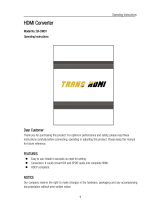
9
12. FAQ’s
7) If problems persist, swap out the IR emitters and
receivers to rule out faults with the units themselves. Use
emitters you know are fully operational to test working
condition.
8) Reactivate the IR callback function on your matrix and
swap IR ports on the matrix to rule out a fault with the
device connection ports.
9) Should IR remain unresponsive, turn off and disconnect
all cables and reconnect zones one at a time to assess
if one location in particular is the problem. If so, run new
cables directly to the display – if this fixes the problem, it
is likely that electromagnetic interference /damage to the
cable somewhere along the run is causing the IR signal
to drop out. Investigate and remove EM interference from
the run or replace damaged UTP cable.
5e or 6?
While our equipment is tested and graded to Cat 5e
cable standard; tests have shown that better results
are achieved when using Cat6 cable. The lower gauge,
thicker copper cores ensure better signal transfer.
Newly installed cabling should always conform to Part P
Regulation and BS 7671 (17th Edition), and should be
terminated to 568B standard
Can I use a single Cat 5e cable?
Although conventional transmission is considered to be
two Cat 5e cables, it is possible to send the signal down
a single cable if necessary. All of our pro-matrix switches
and UTP splitters support single UTP mode, however in
this mode IR control of sources and matrix switching is
not possible. However using HDBaseT transmission; all
of the twin cable features are supported with the added
benefit of Ethernet and RS232 control.
How far can the signal travel?
Under perfect transmission conditions our HD receivers
will operate at 30, 50 or 100m (@1080p) depending on
the model used. Perfect conditions mean no electrical
interference, straight cable runs with no bends or kinks
and no patch panels or wall outlets. If some of the
above are factors in your installation then signal strength
and bandwidth can be compromised. If a cable run is
reaching the upper limit of the receivers’ capabilities,
then the signal can be boosted by way of an extender
set (Rx TX) or by simply using an in-line repeater. Our
transmission signals can be repeated up to 5 times
(250m) using a conventional TMDS signal or 7 times
(700m) using HDBaseT technology.
What about 3D?
All of our matrix switches and most of our extender
products will pass-through a 3D Blu-ray signal. The 30m
and Coax extender sets do not support frame sequential
3D (Blu-ray), but will still pass-through interlaced stereo-
scopic 3D (Satellite etc.)
How do I control the sources?
Most of our HDMI distribution products support some
kind of IR pass-through from point-to-point extender sets
to pro and HDBaseT matrices. Most of the range now
supports wideband IR meaning it is compatible with any
IR device available on the market. Our Pro and HDBaseT
matrix range (Cat 5e) has IR pass-through from each of
the outputs and has discrete IR outputs at the switch
end, meaning you can have multiple identical sources yet
the IR would be routed only to the applicable source.
Do I need power at the TV end?
Yes. Our HD display adaptors require a 5v power supply
at the TV end to operate. It’s important that these are
powered locally and do not receive remote power from
the rack as there can be issues resulting from voltage
drop along the length of cable. Our new USB power
cables overcome the problem of having a second mains
outlet behind the TV. These useful leads draw the 5v from
the USB socket on the TV to power the receiver, this also
means that the receiver is only powered when the TV is
on making the system more environmentally friendly.
Do I need to use 1 or 2 cables?
Using our conventional pro (TMDS) transmission method
the Video & Audio is sent along cable #2, IR and
HDCP data is sent along cable #1. Using our HDBaseT
technology it’s possible to send Audio (up to DTS Master),
Video (up to 4k), Ethernet (10/100), and control (RS232 &
2-way IR) down a single Cat 5e cable.
Are WyreStorm products compatible with
HDMI 1.4?
HDMI 1.4 refers to a list of ‘features’ that a device is
capable of supporting, including Ethernet channel, return
audio channel, 3D etc. Due to the continuously evolving
nature of the technology, HDMI Licensing LLC have now
decided to simplify terminology by testing and referring to
cable in terms of STANDARD or HIGH-SPEED rather than
in generations 1.3, 1.4 etc.
• STANDARD (or “category 1”) HDMI cables perform
at speeds of 75Mhz or up to 6.75Gbps, which is the
equivalent to a 720p/1080i signal.
FAQ’S















